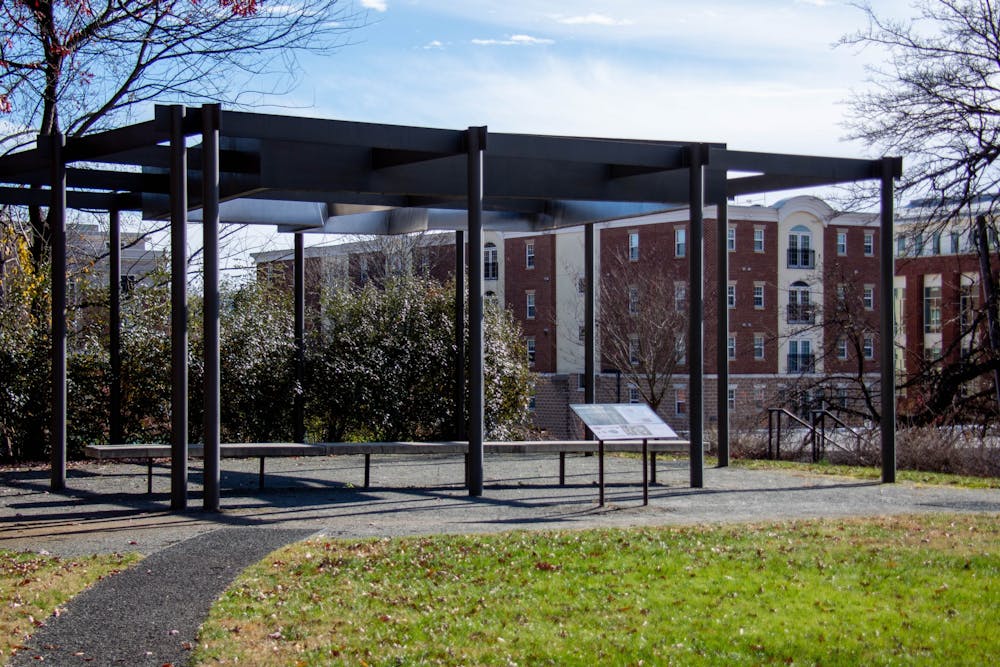Every day, students walk past the Kitty Foster Memorial located right outside of Nau Hall. Dedicated in 2011, the memorial includes a metal “shadow catcher” structure to sit where her house did and a small wall outlining a cemetery for the predominantly free Black community Foster was a part of. There are also three brief, faded informational signs. While the memorial highlights the archaeological importance of the site, it should provide more vital information and context to the significance of Foster and the broader Venable Lane community.
Foster was a free Black woman who owned over two acres and a house just south of the University in the 1800s. She moved to this area after becoming free from slavery in 1820 and proceeded to raise five children on the property while working as a washerwoman for the University. She lived here until her death in 1863 and was a part of the broader free Black community at Venable Lane, often referred to as “Canada.” The exact origins of the name “Canada” have not been identified, but some believe it to be related to the abolishment of enslavement in British Canada territory that occurred as the community was being formed. Some have also suggested this name was intended to be derogatory, denoting a place that is “geographically close but culturally distant.”
Located within Grounds, Venable Lane is an example of a community of free Black Americians who overcame many racial and economic adversities prevalent in the American South. This fact becomes evident in examining a 2003 archaeological report on the site. The community held a variety of occupations. Many worked as washerwomen, seamstresses, carpenters and brickmasons for the University. In addition to housing a sizable renting population, the community also offered the conditions for Black property ownership as lots were subdivided and sold amongst Black Americans. For many Black Americans during this time period, owning and managing a home was unattainable, as government institutions and the private housing market worked against people of color.
The University must justly memorialize the Venable Lane Community. However, this has not been accomplished by the Kitty Foster Memorial. The memorial leaves out vital information about the Venable Lane community and significance of Black property ownership. The community is only mentioned once on an information sign that simply states the community existed. Informational signs are available addressing the community within Gibson Hall, but on the memorial these informational posters are only referenced in regard to Kitty Foster specifically, not the Venable Lane community. New informational signage that specifically addresses the significance of the Venable Lane community should be included as part of the Kitty Foster Memorial.
Furthermore, the University's role in the community's premature demise should be acknowledged within added informational signage. The University’s suppression of the Venable Lane community can be linked to the construction of Old Cabell Hall to, in part, shield the University from the community. Shortly after the building's construction, a huge influx of white developers and residents moved into the region in the early 1900 and implemented racially restrictive covenants in deeds. These covenants prevented the sale of the property to people of color. Conveniently, in the 1970s the University acquired a majority of the land that once made up the community, and today has expanded academic buildings, residence halls and a student health center where the neighborhood once existed. This is just one example of a coordinated effort between Charlottesville and the University to remove Black communities from locations around the University. The memorial fails to draw important connections between the intersecting history of the community and University. The influential role that the University played in the community's demise is vital to the understanding of this site and should be acknowledged within the memorial.
Recent attention has focused on the recontextualization or removal of other memorials and monuments on Grounds and in Charlottesville. Specifically, the University and Board of Visitors has put substantial efforts into a recontextualization of the newly named Whispering Wall, formerly a memorial to a Confederate soldier. With only the removal of an inscription and a lacking digital contextualization project, these efforts have been criticized. And while the Memorial to Enslaved Laborers was a leap forward in recognizing and memorializing Black history on Grounds, it should not be a stopping point in our efforts.
Given the current failures of the Kitty Foster Memorial to justly recognize and memorialize the Venable Lane Community, the Board should establish an inclusive committee with relevant stakeholders to further investigate and make recommendations to address the memorial’s shortcomings. At the bare minimum, this should constitute an added informational sign focusing on the community and its intersection with University history on the memorial. We have the responsibility to justly memorialize the free Black community of people that lived here. It is imperative that the memorial is able to accurately inform future social justice discussions and policy.
Jacob Rizzio is a Viewpoint Writer who writes about Administration for The Cavalier Daily. He can be reached at opinion@cavalierdaily.com.
The opinions expressed in this column are not necessarily those of The Cavalier Daily. Columns represent the views of the authors alone.





